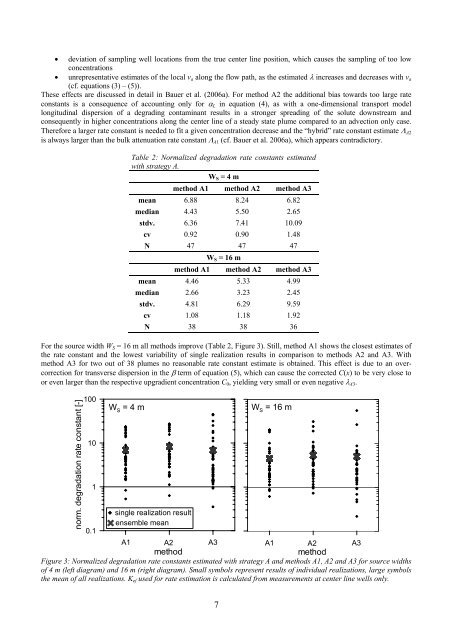Applied numerical modeling of saturated / unsaturated flow and ...
Applied numerical modeling of saturated / unsaturated flow and ...
Applied numerical modeling of saturated / unsaturated flow and ...
Create successful ePaper yourself
Turn your PDF publications into a flip-book with our unique Google optimized e-Paper software.
• deviation <strong>of</strong> sampling well locations from the true center line position, which causes the sampling <strong>of</strong> too low<br />
concentrations<br />
• unrepresentative estimates <strong>of</strong> the local va along the <strong>flow</strong> path, as the estimated λ increases <strong>and</strong> decreases with va<br />
(cf. equations (3) – (5)).<br />
These effects are discussed in detail in Bauer et al. (2006a). For method A2 the additional bias towards too large rate<br />
constants is a consequence <strong>of</strong> accounting only for αL in equation (4), as with a one-dimensional transport model<br />
longitudinal dispersion <strong>of</strong> a degrading contaminant results in a stronger spreading <strong>of</strong> the solute downstream <strong>and</strong><br />
consequently in higher concentrations along the center line <strong>of</strong> a steady state plume compared to an advection only case.<br />
Therefore a larger rate constant is needed to fit a given concentration decrease <strong>and</strong> the “hybrid” rate constant estimate ΛA2<br />
is always larger than the bulk attenuation rate constant ΛA1 (cf. Bauer et al. 2006a), which appears contradictory.<br />
Table 2: Normalized degradation rate constants estimated<br />
with strategy A.<br />
WS = 4 m<br />
method A1 method A2 method A3<br />
mean 6.88 8.24 6.82<br />
median 4.43 5.50 2.65<br />
stdv. 6.36 7.41 10.09<br />
cv 0.92 0.90 1.48<br />
N 47 47 47<br />
WS = 16 m<br />
method A1 method A2 method A3<br />
mean 4.46 5.33 4.99<br />
median 2.66 3.23 2.45<br />
stdv. 4.81 6.29 9.59<br />
cv 1.08 1.18 1.92<br />
N 38 38 36<br />
For the source width WS = 16 m all methods improve (Table 2, Figure 3). Still, method A1 shows the closest estimates <strong>of</strong><br />
the rate constant <strong>and</strong> the lowest variability <strong>of</strong> single realization results in comparison to methods A2 <strong>and</strong> A3. With<br />
method A3 for two out <strong>of</strong> 38 plumes no reasonable rate constant estimate is obtained. This effect is due to an overcorrection<br />
for transverse dispersion in the β term <strong>of</strong> equation (5), which can cause the corrected C(x) to be very close to<br />
or even larger than the respective upgradient concentration C0, yielding very small or even negative λA3.<br />
norm. degradation rate constant [-]<br />
100<br />
10<br />
1<br />
W S = 4 m W S = 16 m<br />
single realization result<br />
ensemble mean<br />
0.1<br />
A1 1 A2 2 A3 3<br />
A1 1 A2 2 A3 3<br />
method<br />
method<br />
Figure 3: Normalized degradation rate constants estimated with strategy A <strong>and</strong> methods A1, A2 <strong>and</strong> A3 for source widths<br />
<strong>of</strong> 4 m (left diagram) <strong>and</strong> 16 m (right diagram). Small symbols represent results <strong>of</strong> individual realizations, large symbols<br />
the mean <strong>of</strong> all realizations. Kef used for rate estimation is calculated from measurements at center line wells only.<br />
7

















